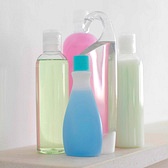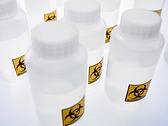Earth Day Experiment: My Plastic Inventory

- Alarm clock
- Shampoo bottle
- Soap holder
- Razor
- Moisturizer
- Sunscreen
- Deodorant
- Toothbrush
- Toothpaste
- Dental floss container
- Trashcan
- Hairdryer
- Hair products
- Medicine container
- Make up pods
- Lip balm
- Cereal liner
- Milk carton
- Toaster (plastic lever)
- Yogurt cup
- Dried fruit container
- Hot water kettle (for tea)
- iPhone case
- iPhone charger (wires are coated in plastic and the charging base is plastic)
- Credit cards (made of plastic)
- Car (so many parts are made of PVCs and other plastics)
- Hand sanitizer
- Tissue soft pack
- Desktop screen
- Keyboard
- Desk phone
- Pen
- Presentation remote
- Elevator button
- Bread bag
- Deli meat container
- Condiment jar
- Refrigerator
- Snack zip-top bag
- Frozen vegetable bags
- Food packaging
- Radio/CD player
- Light switches
- DVD case
- TV Remote control
- TV
- Camera (I take pictures nearly every day with a digital SLR, but the body is mostly plastic)
- Various gym equipment (this could get long – think treadmill, bike helmet, swim goggles, push up bar, etc)
- Random kitchen tools like spatulas, measuring cups
- Dishwashing soap
- Sponge scrubber
- Dish drying rack
- Laundry soap and measuring cap
To be fair, plastic is unavoidable in certain things and in some ways it can reduce the weight of products or increase the convenience. But as I kept tallying – day after day – I kept realizing I could make better choices and cut down on the plastic in my life. For the last 36 days, I’ve been tweeting the 1 green thing (see #my1greenthing) and challenging myself to make an effort to be better for my health and the environment. Thankfully my water bottle is glass with silicone grippers and cap and I switched to glass food storage containers. Small changes add up.
So what do you think? Or better still send me your Daily Plastics Number and any tips you have to cut down on the plastic.
Earth Day Experiment: My Plastic Inventory Read More »


